Index
Details
Cover
Preface Extract
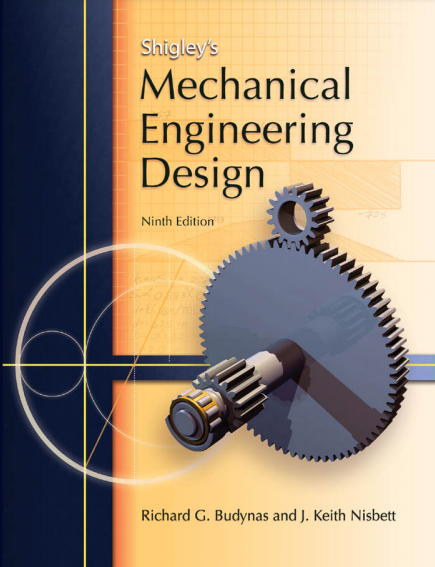
This text is intended for students beginning the study of mechanical engineering design. The focus is on blending fundamental development of concepts with practical specification of components. Students of this text should find that it inherently directs them into familiarity with both the basis for decisions and the standards of industrial components. For this reason, as students transition to practicing engineers, they will find that this text is indispensable as a reference text. The objectives of the text are to: • Cover the basics of machine design, including the design process, engineering mechanics and materials, failure prevention under static and variable loading, and characteristics of the principal types of mechanical elements • Offer a practical approach to the subject through a wide range of real-world applications and examples • Encourage readers to link design and analysis • Encourage readers to link fundamental concepts with practical component specification.
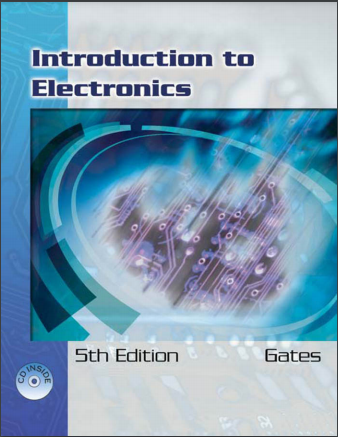
Introduction to Electronics is intended to meet the needs of a one-year program in electronics for high schools, vocational schools, career colleges, and community colleges. The book may also be used in a survey course in electronics for electronics technology, computer technology, and telecommunications. The fifth edition continues to give students the basic background that more closely relates to the needs of industry. It provides the hands-on instruction required by industry along with the required theory

This is an introductory book on the subject of mechatronics. It can serve as both a textbook and a reference book for engineering students and practicing professionals, respectively. As a textbook, it is suitable for undergraduate or entry-level graduate courses in mechatronics, mechatronic devices and components, sensors and actuators, electromechanical systems, system modeling and simulation, and control system instrumentation. Mechatronics concerns the synergistic and concurrent use of mechanics, electronics, computer engineering, and intelligent control systems in modeling, analyzing, designing, developing, implementing, and controlling smart electromechanical products. As modern machinery and electromechanical devices are typically being controlled using analog and digital electronics and computers, the technologies of mechanical engineering in such a system can no longer be isolated from those of electronic and computer engineering.
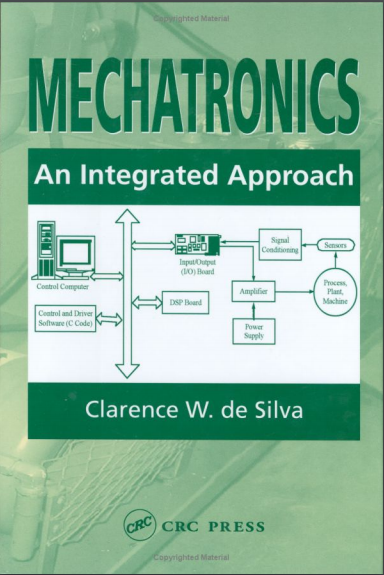
This is an introductory book on the subject of Mechatronics. It will serve as both a textbook and a reference book for engineering students and practicing professionals. Mechatronics concerns synergistic and concurrent use of mechanics, electronics, computer engineering, and intelligent control systems in modeling, analyzing, designing, developing, and implementing smart electromechanical products. As the modern machinery and electromechanical devices are typically being controlled using analog and digital electronics and computers, the technologies of mechanical engineering in such a system can no longer be isolated from those of electronic and computer engineering. For example, in a robot system or a micromachine, mechanical components are integrated with analog and digital electronic components to provide single functional units or products. Similarly, devices with embedded and integrated sensing, actuation, signal processing, and control have many practical advantages. In the framework of Mechatronics, a unified approach is taken to integrate different types of components and functions, both mechanical and electrical, in modeling, analysis, design, and implementation, with the objective of harmonious operation that meets a desired set of performance specifications.
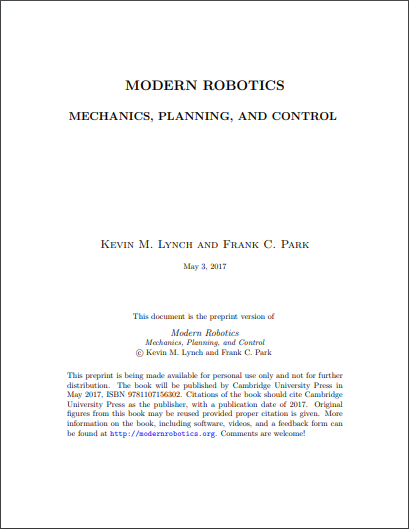
We believe that there is a distinct and unifying perspective to mechanics, planning, and control for robots that is lost if these subjects are studied independently, or as part of other more traditional subjects. At the 2008 meeting, we noted the lack of a textbook that (a) treated these topics in a unified way, with plenty of exercises and figures, and (b), most importantly, was written at a level appropriate for a first robotics course for undergraduates with only freshman-level physics, ordinary di↵erential equations, linear algebra, and a little bit of computing background. We decided that the only sensible recourse was to write such a book ourselves. A second motivation for this book, and one that we believe sets it apart from other introductory treatments on robotics, is its emphasis on modern geometric techniques. Often the most salient physical features of a robot are best captured by a geometric description. The advantages of the geometric approach have been recognized for quite some time by practitioners of classical screw theory. What has made these tools largely inaccessible to undergraduates—the primary target audience for this book—is that they require an entirely new language of notations and constructs (screws, twists, wrenches, reciprocity, transversality, conjugacy, etc.), and their often obscure rules for manipulation and transformation. On the other hand, the mostly algebraic alternatives to screw theory often mean that students end up buried in the details of calculation, losing the simple and elegant geometric interpretation that lies at the heart of what they are calculating.
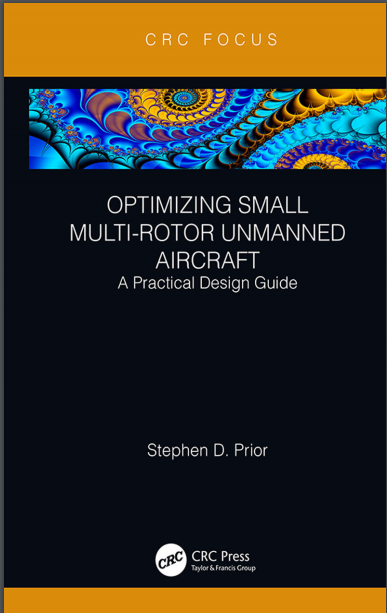
This design guide was written to capture the author’s practical experience of designing, building and testing multi-rotor systems over the past decade. The lack of one single source of useful information, meant that the last 10 years has been a steep learning curve, a lot of self-tuition and many trial and error tests. Lessons learnt the hard way are not always the best way to learn. As one of my previous lecturers said: ‘Learn from the mistakes of others, rather than from your own mistakes’. However, when you are operating at the cutting edge, it is hard to find examples to follow. Some aspects of this guide are deliberately focussed on design solutions to the IMechE UAS Challenge, which is an international design competition set up by the Institution of Mechanical Engineers in the UK and first run in the summer of 2015. The basic premise of this competition is to design, build and test a small (< 7 kg), low-cost (< £ 1k), autonomous Unmanned Aircraft (UA) (FW or RW) to deliver a humanitarian aid payload (up to 3 kg) accurately to a target GPS waypoint location approximately 1 km away from the take-off point.
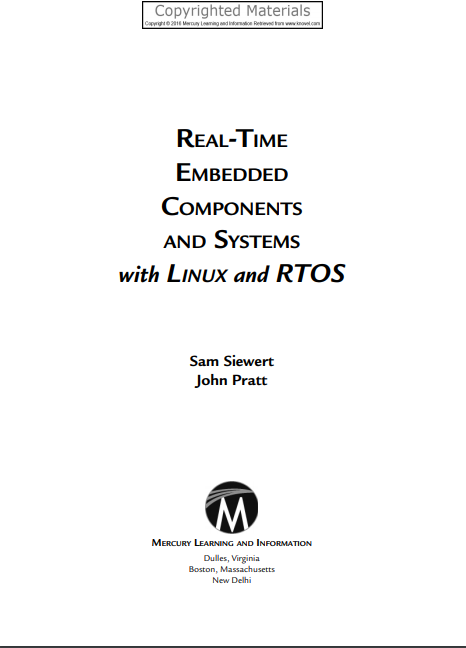
This book is intended to provide the practicing engineer with the necessary background to apply real-time theory to the design of embedded components and systems in order to successfully field a real-time embedded system. The book also is intended to provide a senior-year undergraduate or first-year graduate student in electrical engineering, computer science, or related fields of study with a balance of fundamental theory, review of industry practice, and hands-on experience to prepare for a career in the real-time embedded system industries. Typical industries include aerospace, medical diagnostic and therapeutic systems, telecommunications, automotive, robotics, industrial process control, media systems, computer gaming, and electronic entertainment, as well as multimedia applications for general-purpose computing. Real-time systems have traditionally been fielded as hard real-time applications, such as digital flight control systems, antilock braking systems, and missile guidance. More recently, however, intense interest in soft real-time systems has arisen due to the quickly growing market for real-time digital media services and systems.
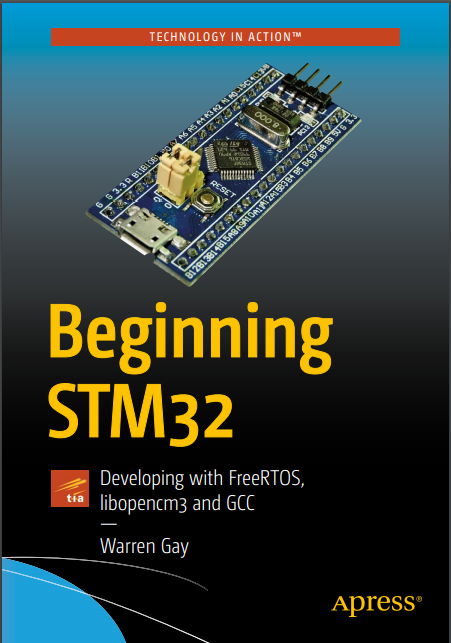
There is considerable interest in the ARM Cortex platform today because ARM devices are found everywhere. Units containing ARM devices range from the small microcontroller embedded systems to cellphones and larger servers running Linux. Soon, ARM will also be present in higher numbers in the datacenter. These are all good reasons to become familiar with ARM technology. With the technology ranging from microcontrollers to full servers, the question naturally arises: “Why study embedded device programming? Why not focus on enduser systems running Linux, like the Raspberry Pi?” The simple answer is that embedded systems perform well in scenarios that are awkward for larger systems. They are frequently used to interface with the physical world. They go between the physical world and a desktop system, for example. The humble keyboard uses a dedicated MCU (microcontroller unit) to scan key switches of the keyboard and report key-press events to the desktop system. This not only reduces the amount of wiring necessary but also frees the main CPU from expending its highperformance computing on the simple task of noticing key-press events. Other applications include embedded systems throughout a factory floor to monitor temperature, security, and fire detection. It makes little sense to use a complete desktop system for this type of purpose. Stand-alone embedded systems save money and boot instantly. Finally, the MCU’s small size makes it the only choice in flying drones where weight is a critical factor.
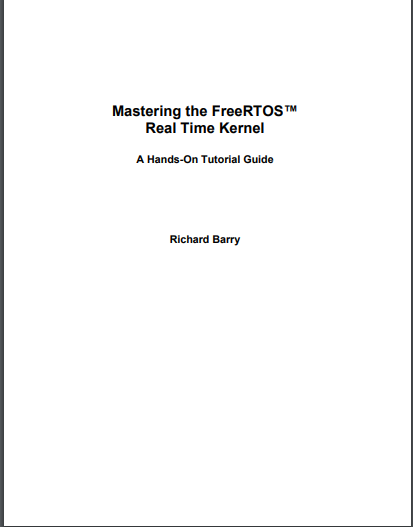
FreeRTOS is a real-time kernel (or real-time scheduler) on top of which embedded applications can be built to meet their hard real-time requirements. It allows applications to be organized as a collection of independent threads of execution. On a processor that has only one core, only a single thread can be executing at any one time. The kernel decides which thread should be executing by examining the priority assigned to each thread by the application designer. In the simplest case, the application designer could assign higher priorities to threads that implement hard real-time requirements, and lower priorities to threads that implement soft real-time requirements. This would ensure that hard real-time threads are always executed ahead of soft real-time threads, but priority assignment decisions are not always that simplistic.

This document provides a technical reference to both the primary FreeRTOS API1, and the FreeRTOS kernel configuration options. It is assumed the reader is already familiar with the concepts of writing multi tasking applications, and the primitives provided by real time kernels. Readers that are not familiar with these fundamental concepts are recommended to read the book “Mastering the FreeRTOS Real Time Kernel – A Practical Guide” for a much more descriptive, hands on, and tutorial style text.
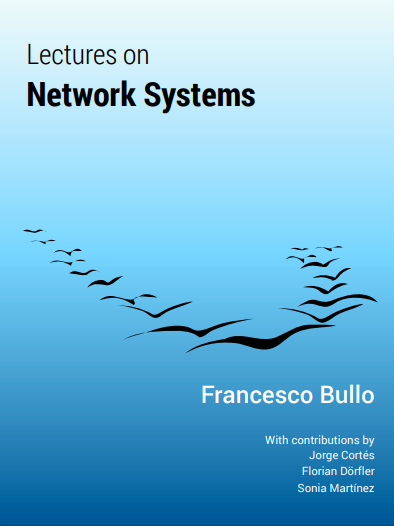
These lecture notes provide a mathematical introduction to multi-agent dynamical systems, including their analysis via algebraic graph theory and their application to engineering design problems. The focus is on fundamental dynamical phenomena over interconnected network systems, including consensus and disagreement in averaging systems, stable equilibria in compartmental flow networks, and synchronization in coupled oscillators and networked control systems. The theoretical results are complemented by numerous examples arising from the analysis of physical and natural systems and from the design of network estimation, control, and optimization systems.The book is organized in three parts: Linear Systems, Topics in Averaging Systems, and Nonlinear Systems.

Due to many exciting developments in the fields of robotics, artificial intelligence, and control theory, three topics that were once quite distinct are presently on a collision course. In robotics, motion planning was originally concerned with problems such as how to move a piano from one room to another in a house without hitting anything. The field has grown, however, to include complications such as uncertainties, multiple bodies, and dynamics. In artificial intelligence, planning originally meant a search for a sequence of logical operators or actions that transform an initial world state into a desired goal state. Presently, planning extends beyond this to include many decision-theoretic ideas such as Markov decision processes, imperfect state information, and game-theoretic equilibria. Although control theory has traditionally been concerned with issues such as stability, feedback, and optimality, there has been a growing interest in designing algorithms that find feasible open-loop trajectories for nonlinear systems. In some of this work, the term “motion planning” has been applied, with a different interpretation from its use in robotics. Thus, even though each originally considered different problems, the fields of robotics, artificial intelligence, and control theory have expanded their scope to share an interesting common ground. In this text, I use the term planning in a broad sense that encompasses this common ground

This book provides a comprehensive introduction into the emerging field of probabilistic robotics. Probabilistic robotics is a subfield of robotics concerned with perception and control. It relies on statistical techniques for representing information and making decisions. By doing so, it accommodates the uncertainty that arises in most contemporary robotics applications. In recent years, probabilistic techniques have become one of the dominant paradigms for algorithm design in robotics. This monograph provides a first comprehensive introduction into some of the major techniques in this field. This book has a strong focus on algorithms. All algorithms in this book are based on a single overarching mathematical foundation: Bayes rule, and its temporal extension known as Bayes filters. This unifying mathematical framework is the core commonality of probabilistic algorithms.

In software development, e.g., this evolution can be seen quite clearly. Development tools have known increasingly larger components (from 0/1 to classes/objects) from the times we used punch cards, and then Assembler, and then procedural programming languages, and eventually object-oriented languages, thus facilitating the description of complex systems. The evolution to the next generation has already begun: The graphical Unifi ed Modeling Language ( UML) has become increasingly popular for developing software systems, and it is being used to solve more and more tasks that had been previously done with conventional programming languages. In systems engineering (system development) the boundaries between the different disciplines continue to blur. Especially software is used in more and more fi elds. These hybrid systems represent a particular challenge to the development. We can use proven methods to effi ciently develop individual components of a complete system.
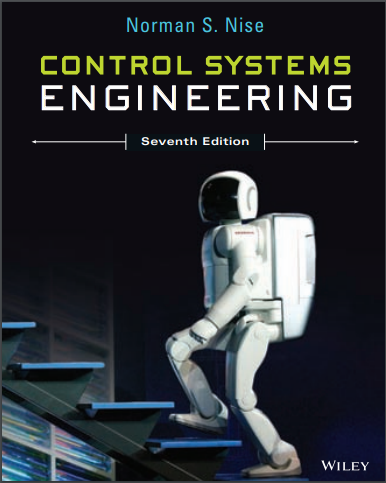
This book introduces students to the theory and practice of control systems engineering. The text emphasizes the practical application of the subject to the analysis and design of feedback systems. The study of control systems engineering is essential for students pursuing degrees in electrical, mechanical, aerospace, biomedical, or chemical engineering. Control systems are found in a broad range of applications within these disciplines, from aircraft and spacecraft to robots and process control systems. Control Systems Engineering is suitable for upper-division college and university engineering students and for those who wish to master the subject matter through self-study. The student using this text should have completed typical lower-division courses in physics and mathematics through differential equations. Other required background material, including Laplace transforms and linear algebra, is incorporated in the text, either within chapter discussions or separately in the appendixes or on the book's Companion Web site.
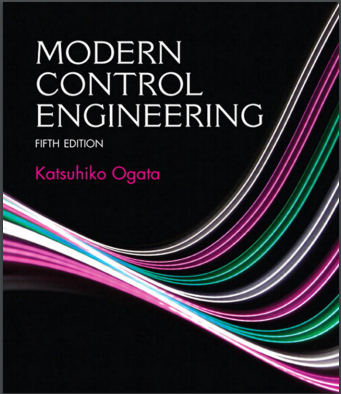
This book introduces important concepts in the analysis and design of control systems. Readers will find it to be a clear and understandable textbook for control system courses at colleges and universities. It is written for senior electrical, mechanical, aerospace, or chemical engineering students. The reader is expected to have fulfilled the following prerequisites: introductory courses on differential equations, Laplace transforms, vectormatrix analysis, circuit analysis, mechanics, and introductory thermodynamics.

This book provides an introduction to the basic principles and tools for the design and analysis of feedback systems. It is intended to serve a diverse audience of scientists and engineers who are interested in understanding and utilizing feedback in physical, biological, information and social systems. We have attempted to keep the mathematical prerequisites to a minimum while being careful not to sacrifice rigor in the process. We have also attempted to make use of examples from a variety of disciplines, illustrating the generality of many of the tools while at the same time showing how they can be applied in specific application domains. A major goal of this book is to present a concise and insightful view of the current knowledge in feedback and control systems.
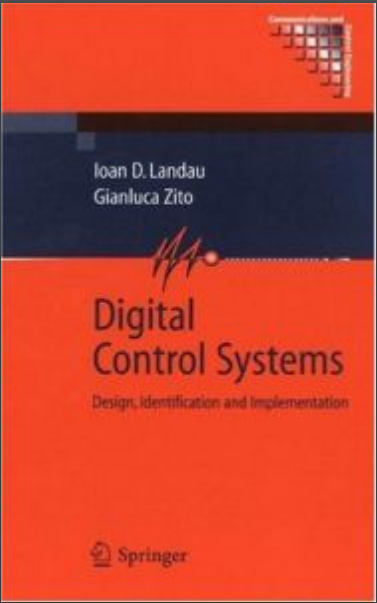
The extraordinary development of digital computers (microprocessors, microcontrollers) and their extensive use in control systems in all fields of applications has brought about important changes in the design of control systems. Their performance and their low cost make them suitable for use in control systems of various kinds which demand far better capabilities and performances than those provided by analog controllers. However, in order really to take advantage of the capabilities of microprocessors, it is not enough to reproduce the behavior of analog (PID) controllers. One needs to implement specific and high-performance model based control techniques developed for computer-controlled systems (techniques that have been extensively tested in practice). In this context identification of a plant dynamic model from data is a fundamental step in the design of the control system. The book takes into account the fact that the association of books with software and on-line material is radically changing the teaching methods of the control discipline.
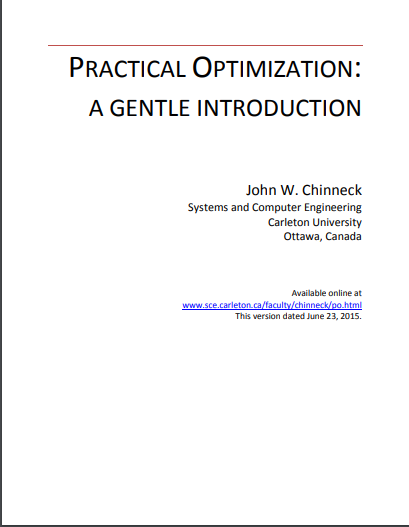
Practical optimization is the art and science of allocating scarce resources to the best possible effect. Optimization techniques are called into play every day in questions of industrial planning, resource allocation, scheduling, decision-making, etc. For example, how does a global petroleum refiner decide where to buy crude oil, where to ship it for processing, what products to convert it to, where to sell those products, and at what prices? A maximum-profit optimization model is used to solve this problem. How does an airline know how to route its planes and schedule its crews at minimum cost while meeting constraints on airplane flight hours between maintenance and maximum flight time for crews? A minimum-cost optimization model is used.
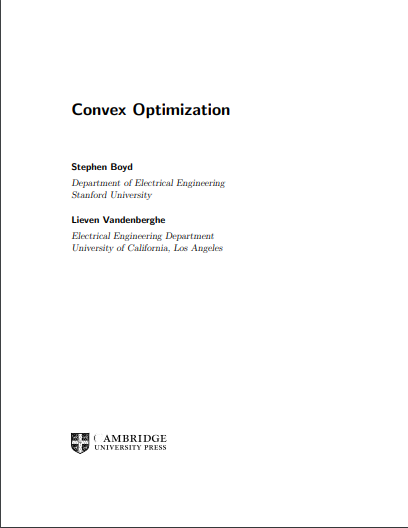
This book is about convex optimization, a special class of mathematical optimization problems, which includes least-squares and linear programming problems. It is well known that least-squares and linear programming problems have a fairly complete theory, arise in a variety of applications, and can be solved numerically very efficiently. The basic point of this book is that the same can be said for the larger class of convex optimization problems. Our main goal is to help the reader develop a working knowledge of convex optimization, i.e., to develop the skills and background needed to recognize, formulate, and solve convex optimization problems
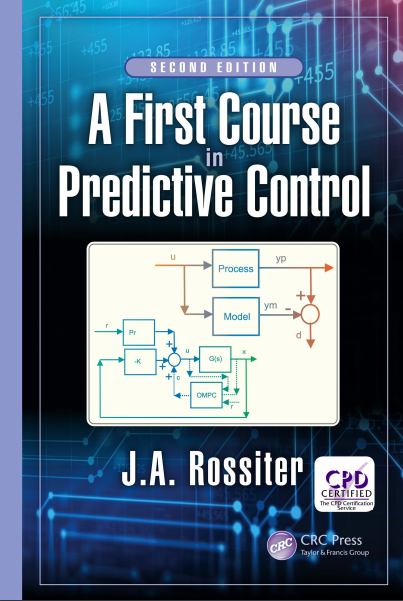
The main aim is to create a focussed and affordable textbook which is suitable for a single or beginners course on model predictive control (MPC) Insight is given in a non-theoretical way and there are a number of summary boxes to give a quick picture of the key results without the need to read through the detailed explanation. There is a strong focus on the philosophy of predictive control answering the questions, ‘why?’ and ‘does it help me?’ The basic concepts are introduced and then these are developed to fit different purposes: for instance, how to model, to predict, to tune, to handle constraints, to ensure feasibility, to guarantee stability and to consider what options there are with regard to models, algorithms, complexity versus performance, and so forth. Research students who want to study predictive control in more depth are advised to make use of the research literature which is very extensive, but even for them I hope they find the focus on concepts in this book will be an invaluable foundation.
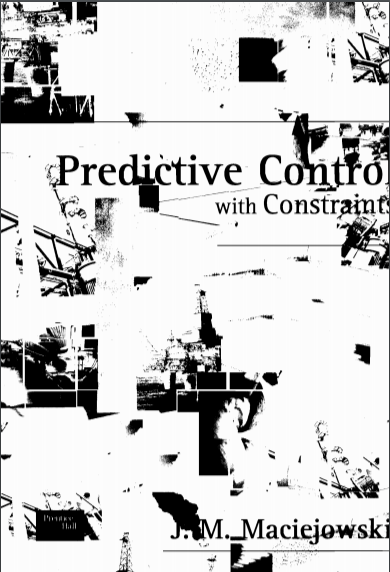
Predictive control was developed and used in industry for nearly 20 years before attracting much serious attention from the academic control community. This community tended to ignore its potential for dealing with constraints, thus missing its main advantage. In addition, it tended to point to the fact that, when constraints are ignored, predictive control is equivalent to conventional, though generally `advanced', linear control, and hence apparently nothing new. This is true, but again misses the important point that issues such as tunability and understandability are crucial for the acceptance of a control technology, at least in the process control environment. Fortunately the academic community has for some years now appreciated that predictive control really does offer something new for control in the presence of constraints, and has provided much analysis, and new ideas, to such an extent that it has gone beyond current industrial practice, and is preparing the ground for much wider application of predictive control -- potentially to almost all control engineering problems. The constant increase in computing speed and power certainly makes that a real prospect. In this book I have attempted to bring everything together. I have tried to convey the simplicity of the underlying concepts of predictive control, but also to show how it relates to existing control theory, and indeed how much more can be done with it when its use is informed by a knowledge of standard control techniques, such as state estimation, disturbance modelling, and frequency response analysis.
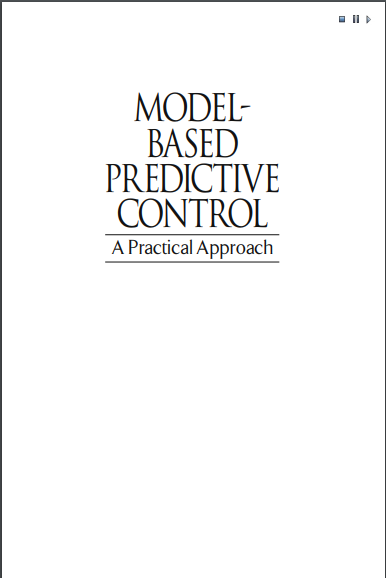
The main aim of this book is to make the presentation less mathematically formal and hence more palatable for the less mathematically inclined. Insight is given in a non-theoretical way and there are a number of summary boxes to give a quick picture of the key results without the need to read through the detailed explanation. The book can serve a twofold purpose: first as a textbook for graduate students and industrialists covering a detailed introduction to predictive control with a strong focus on the philosophy answering the questions, ‘why?’ and ‘does it help me?’ The basic concepts are introduced and then these are developed to fit different purposes: for instance, how to model, to give robustness, to handle constraints, to ensure feasibility, to guarantee stability and to consider what options there are with regard to models, algorithms, complexity versus performance, etc. The second role of the book is to target researchers in predictive control. In places the book goes into more depth, particularly in those areas where Dr. Rossiter has expertise.
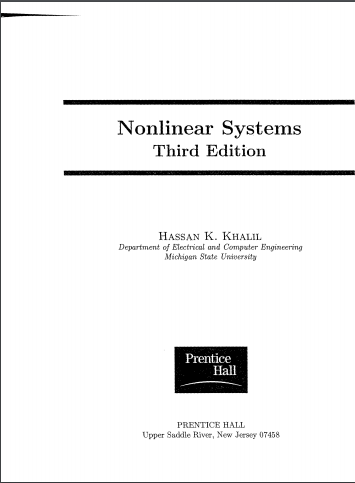
This text is intended for a first—year graduate—level course on nonlinear systems or control. It may also be used for self study or reference by engineers and applied mathematicians. It is an outgrowth of my experience teaching the nonlinear systems course at Michigan State University, East Lansing. Students taking this course have had background in electrical engineering, mechanical engineering, or applied math— ematics. The prerequisite for the course is a graduate—level course in linear systems, taught at the level of the texts by Antsaklis and Michel [9], Chen [35], Kailath [94], or Rugh [158]. The linear systems prerequisite allowed me not to worry about in— troducing the concept of ”state” and to refer freely to ”transfer functions,” ”state transition matrices,” and other linear system concepts. The mathematical back— ground is the usual level of calculus, differential equations, and matrix theory that any graduate student in engineering or mathematics would have. In the Appendix, I have collected a few mathematical facts that are used throughout the book. I have written the text in such a way that the level of mathematical sophistication increases as we advance from chapter to chapter.
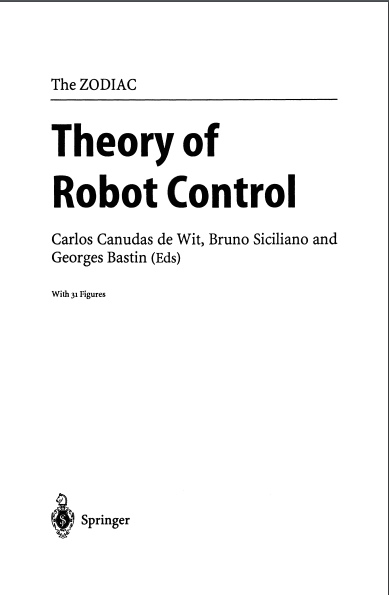
Several advanced control algorithms have been developed for different types of robots (rigid, flexible and mobile), based either on existing control techniques, e.g., feedback linearization and adaptive control, or on new control techniques that have been developed on purpose. Most of those results, although widely spread, are nowadays rather dispersed in different journals and conference proceedings. The purpose of this book is to collect some of the most fundamental and current results on theory of robot control in a unified framework, by editing, improving and completing previous works in the area. The text is addressed to graduate students as well as to researchers in the field.
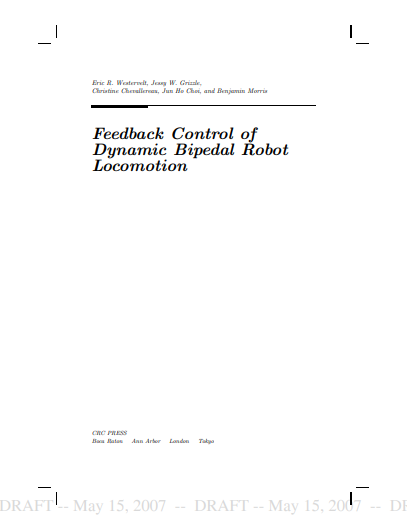
The objective of this book is to present systematic methods for achieving stable, agile and efficient locomotion in bipedal robots. The fundamental principles presented here can be used to improve the control of existing robots and provide guidelines for improving the mechanical design of future robots. The book also contributes to the emerging control theory of hybrid systems. Models of legged machines are fundamentally hybrid in nature, with phases modeled by ordinary differential equations interleaved with discrete transitions and reset maps. Stable walking and running correspond to the design of asymptotically stable periodic orbits in these hybrid systems and not equilibrium points. Past work has emphasized quasi-static stability criteria that are limited to flat-footed walking. This book represents a concerted effort to understand truly dynamic locomotion in planar bipedal robots, from both theoretical and practical points of view.
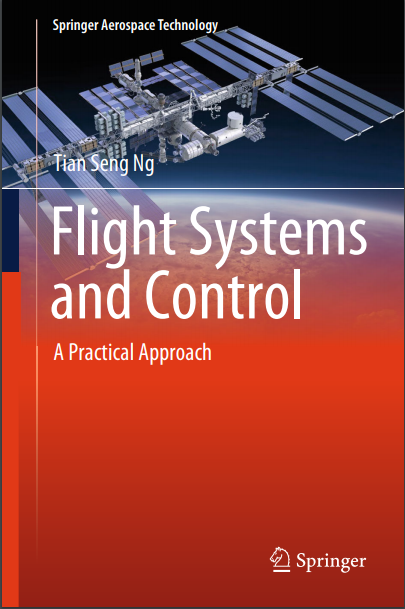
Modern technology in aviation has brought us to the present developments in flight control systems and progressing toward the millenniums. Future transportation will depend heavily on the research investment in the domain of aerospace technology. Fundamentals of aerospace control techniques apply to various flight control systems. Its applications range from the fixed-wing aircraft to the moving blades rotor helicopter system. More advanced air structures like the UAVs, MAVs, quadrotors, etc., implement the same control technology. Furthermore, precise sensors’ feedbacks are responsible for the survival of the flying air vehicles. As can be seen, flight control engineering has made a critical impact on the aerospace industrials. The book starts with the basics of flight mechanics and navigational modules necessary for the flight control system. Illustrative diagrams and graphical programming examples narrate the details of the sensor function design. It also presents the modern developments in unmanned flight systems. Readers can find the various flight computer control and its accessories for flight engineering practices and applications.
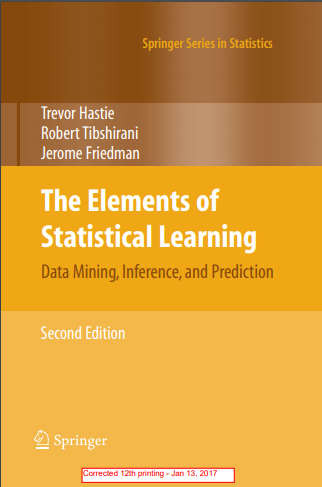
The challenges in learning from data have led to a revolution in the statistical sciences. Since computation plays such a key role, it is not surprising that much of this new development has been done by researchers in other fields such as computer science and engineering. The learning problems that we consider can be roughly categorized as either supervised or unsupervised. In supervised learning, the goal is to predict the value of an outcome measure based on a number of input measures; in unsupervised learning, there is no outcome measure, and the goal is to describe the associations and patterns among a set of input measures. This book is our attempt to bring together many of the important new ideas in learning, and explain them in a statistical framework. While some mathematical details are needed, we emphasize the methods and their conceptual underpinnings rather than their theoretical properties. As a result, we hope that this book will appeal not just to statisticians but also to researchers and practitioners in a wide variety of fields.
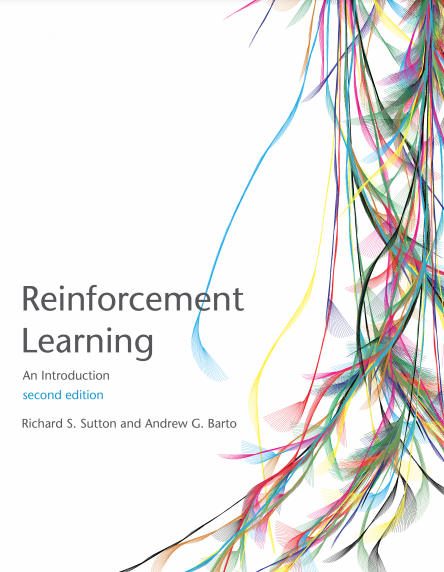
In this book we explore a computational approach to learning from interaction. Rather than directly theorizing about how people or animals learn, we primarily explore idealized learning situations and evaluate the e↵ectiveness of various learning methods.of an artificial intelligence researcher or engineer. We explore designs for machines that are e↵ective in solving learning problems of scientific or economic interest, evaluating the designs through mathematical analysis or computational experiments. The approach we explore, called reinforcement learning, is much more focused on goal-directed learning from interaction than are other approaches to machine learning.
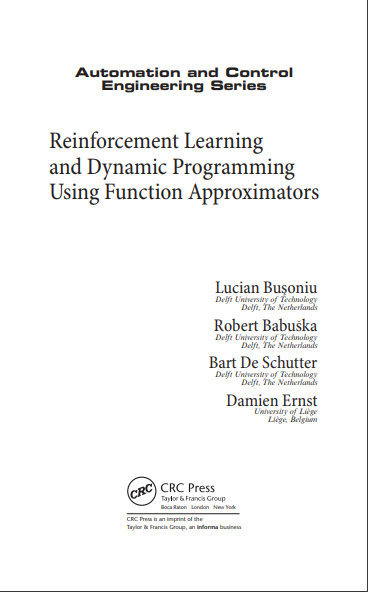
A core obstacle in DP and RL is that solutions cannot be represented exactly for problems with large discrete state-action spaces or continuous spaces. Instead, compact representations relying on function approximators must be used. This challenge was already recognized while the first DP techniques were being developed. However, it has only been in recent years – and largely in correlation with the advance of RL – that approximation-based methods have grown in diversity, maturity, and efficiency, enabling RL and DP to scale up to realistic problems. This book provides an accessible in-depth treatment of reinforcement learning and dynamic programming methods using function approximators. We start with a concise introduction to classical DP and RL, in order to build the foundation for the remainder of the book. Next, we present an extensive review of state-of-the-art approaches to DP and RL with approximation. Theoretical guarantees are provided on the solutions obtained, and numerical examples and comparisons are used to illustrate the properties of the individual methods.

